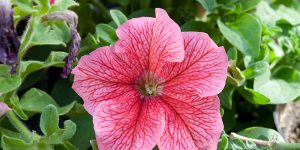DNA

Natural History of the Enigma, Plantimal #4
Eduardo Kac (BR/US)
The central work in the Natural History of the Enigma series is a plantimal, a new lifeform the artist created and that he calls “Edunia,” a genetically engineered flower that is a hybrid of himself and Petunia. The Edunia expresses his DNA exclusively in its red veins.

BLP-2000D
BCL – Georg Tremmel (AT), Shiho Fukuhara (JP)
DNA Synthesisers or ‘DNA Printers’ are devices that chemically synthesise or ‘print’ DNA sequences. Currently, the synthesis of long DNA sequences is still an expensive process, therefore DNA Synthesisers are centralised and offered as a service to universities and research institutions. When a specific DNA sequence is ordered, the DNA information is sent to the company, the DNA is synthesised and returned in its physical form, ready to be used for biological experiments. This centralisation also has an intended side-effect: the companies act as censors, controlling which DNA is to be synthesised—and which not. An unofficial ‘Black List’ of potentially harmful and forbidden DNA Sequences has been created and is shared amongst the companies—officially for bio-security reasons. Because of the expensive chemicals involved in the process, it was not really feasible to create a DIY DNA Synthesiser—until now. DIY microfluidics make the process possible and more affordable. But it is still error-prone and creates mutations in the physical DNA sequences. BLP-2000 creates prototype DNA Synthesisers that only print the 'forbidden,' black-listed DNA Sequences. The process of printing black-listed DNA Sequences also creates a moral and societal dilemma.

Resurrecting the Sublime
Christina Agapakis (US)/Ginkgo Bioworks, Alexandra Daisy Ginsberg (UK), Sissel Tolaas (NO)
The Hibiscadelphus wilderianus was once indigenous to the southern slopes of Mount Haleakalā in Maui, Hawaii, before colonial cattle ranching destroyed the plant's habitat. Resurrecting the Sublime reconstructs the smell of this hibiscus which was last seen in 1912, along with two other extinct species, the Orbexilum stipulatum, and the ‘Leucadendron grandiflorum (Salisb.) R. Br.’


